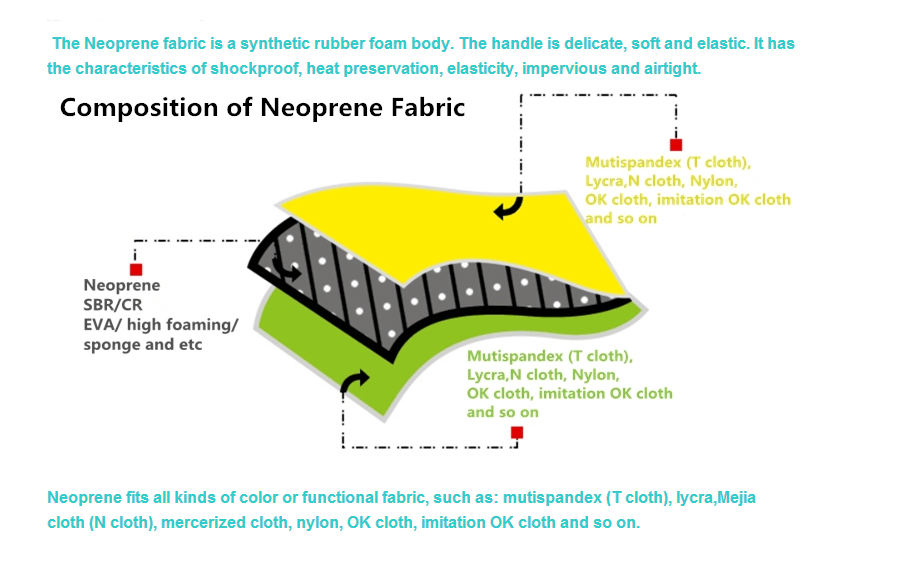Neoprene, the versatile material that’s become a staple in countless applications, from wetsuits to laptop sleeves. It’s well-loved for its flexibility, durability, and, of course, its ability to resist water. But beneath its impressive resume lies a question that often nags at the back of our minds: Is neoprene safe for our health?
Well, let’s put on our detective hats and dive into the world of neoprene safety. We’ll explore its chemical makeup, investigate potential health concerns, and shed light on the regulations and safety measures that are in place. So, buckle up (or, in this case, zip up your neoprene jacket), and let’s embark on this investigative journey.
Neoprene Composition and Chemicals
First things first, let’s get up close and personal with neoprene’s chemical composition. At its core, neoprene is made primarily of chloroprene, a synthetic compound that’s crucial to its water-resistant magic. But, here’s where it gets interesting—neoprene can contain additives and substances during production that could raise some eyebrows.
These additives are like the seasoning in a recipe; they can enhance neoprene’s properties, but they also warrant our attention. Some of them might be harmless, while others could potentially trigger safety concerns. It’s this blend of ingredients that makes us curious about the impact on our health.
Safety Concerns and Health Effects
Alright, now let’s address the elephant in the room: Do we need to worry about our health when we wear neoprene products? The answer isn’t as straightforward as we’d like it to be. Studies have shown that exposure to high levels of chloroprene, the primary component of neoprene, can potentially pose health risks.
But before you start frantically peeling off your wetsuit, it’s essential to put things into perspective. The levels of chloroprene exposure in everyday scenarios, such as wearing a neoprene wetsuit or using a neoprene laptop sleeve, are generally considered to be low and not cause for immediate concern. However, for those working in industries where chloroprene exposure is higher, safety measures and regulations are in place to protect workers.
Regulatory Standards and Safety Measures
To ensure our safety, there are regulatory standards and safety measures governing the production and use of neoprene. Various organizations and agencies keep a watchful eye, making sure that neoprene manufacturers adhere to guidelines that keep our health in mind.
These guidelines include limits on chloroprene exposure levels in the workplace and safety measures to protect workers. For those of us who enjoy neoprene products as part of our daily lives, general safety guidelines can help ensure that we use them without undue concern.
So, while neoprene’s chemical composition might raise questions, it’s important to recognize that safety measures are in place to minimize any potential risks.
In our quest to uncover the truth about neoprene’s safety, we’ve delved into its chemistry, examined potential health effects, and explored the protective measures in place. It’s clear that while neoprene may have some complexities, it can still be enjoyed safely when we follow recommended guidelines.
Stay tuned for the next part of our investigation, where we’ll shift our focus to the environmental impact of neoprene and the role recycling plays in making it a more sustainable choice. Until then, zip up your neoprene gear and enjoy its many benefits, confident in the knowledge that it can be a safe choice for your health.
Circularity and Neoprene Recycling
Now that we’ve addressed the safety concerns surrounding neoprene, let’s pivot to another critical aspect: sustainability. In an era where environmental consciousness is paramount, neoprene doesn’t get a free pass. That’s where the concept of circularity comes into play.
Circularity in Neoprene
Imagine a world where neoprene isn’t just a one-way ticket to a landfill. Circularity is a concept that aims to make this dream a reality. It’s all about reimagining the lifecycle of neoprene products, ensuring they don’t end up as waste but rather find new life.
Recycling Neoprene
Recycling neoprene isn’t just a feel-good gesture; it’s a game-changer for sustainability. Instead of disposing of old neoprene gear, recycling programs can repurpose it into new products. This reduces the demand for virgin neoprene production, which can be resource intensive.
Recycled neoprene isn’t just about minimizing waste; it also conserves energy and resources. Plus, it’s a step towards reducing the environmental footprint of neoprene production.
And the best part? The quality and performance of recycled neoprene are often on par with its virgin counterpart, making it a win-win for both you and the planet.
The Neoprene Industry’s Response
It’s not just environmentalists championing the cause; the neoprene industry itself has taken notice. Manufacturers are increasingly adopting sustainable practices and looking for ways to reduce the environmental impact of neoprene.
Innovations are underway to make neoprene production more eco-friendly. This includes exploring alternative materials, reducing energy consumption, and improving waste management.
Corporate responsibility is on the rise too, with many companies committing to sustainable practices, from sourcing neoprene responsibly to supporting recycling initiatives.
Environmental Impact of Neoprene
Of course, no discussion about sustainability is complete without a look at the bigger picture. Neoprene’s environmental footprint extends beyond just its composition; it encompasses its entire lifecycle.
From the production process to disposal, neoprene has an impact. But here’s the kicker: it’s often a lower impact compared to alternative materials used for similar purposes. The durability and longevity of neoprene products mean they don’t need frequent replacement, reducing waste over time.
When you add recycling into the mix, neoprene’s eco-friendly profile gets even brighter. And that’s something we can all get behind.
Conclusion
So, what have we learned? Neoprene, when used responsibly and with an eye on sustainability, can be a safe and eco-conscious choice. We’ve unraveled the mysteries of its composition, addressed health concerns, and explored its potential for circular flow and recycling.
As you zip up your neoprene gear for your next adventure, remember that you’re part of a growing movement towards a more sustainable future. By choosing products made with care for both your safety and the environment, you’re contributing to a world where neoprene can be enjoyed without guilt.



